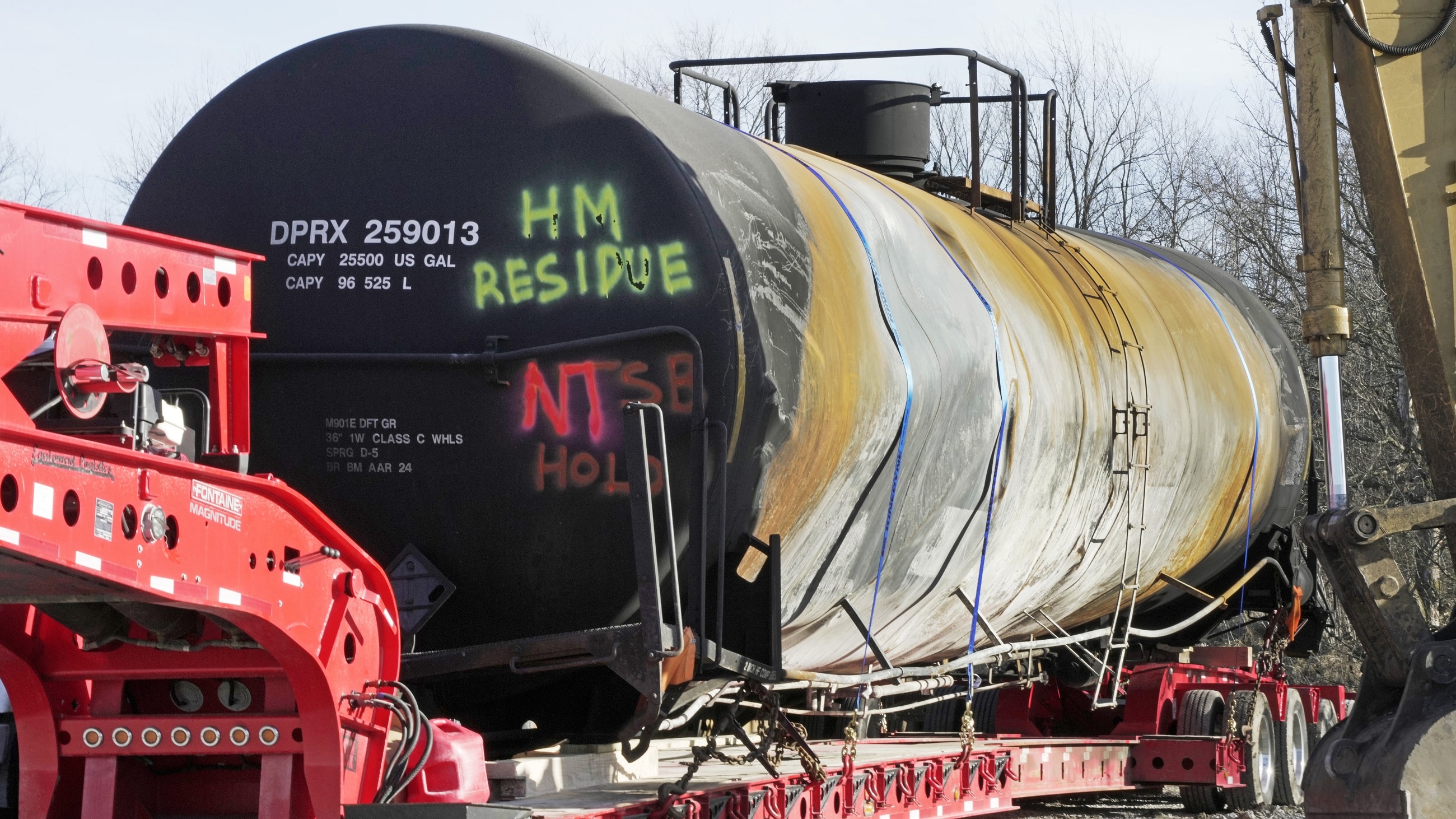Toxic Chemicals From Ohio Train Derailment: Persistence In Buildings

Table of Contents
The February 3, 2023, derailment released a cocktail of hazardous materials, including vinyl chloride, butyl acrylate, and ethylene glycol monobutyl ether. These chemicals are not simply transient pollutants; their properties allow them to persist in the environment and within building structures, creating a long-term health risk demanding immediate attention and decisive action.
The Nature of Persistent Toxic Chemicals
Several factors contribute to the persistence of the chemicals released in the Ohio derailment. These chemicals possess characteristics that allow them to penetrate building materials and remain there for extended periods, leading to prolonged exposure for residents and workers.
- Vinyl chloride: This highly volatile substance readily seeps into porous materials like wood, drywall, and insulation. Its tendency to adsorb onto surfaces means it can be difficult to remove completely.
- Butyl acrylate: Known for its potential for long-term off-gassing, butyl acrylate can slowly release its vapors into the air within buildings for weeks, months, or even years after the initial contamination event. This continuous release contributes to prolonged exposure.
- Building Materials' Role: The very materials designed to protect us from the elements can inadvertently become traps for these chemicals. The porosity of materials like wood, the absorptive capacity of concrete, and the complex structure of drywall all contribute to the retention of toxic chemicals.
These properties significantly complicate cleanup efforts and pose a severe challenge in assessing the extent and duration of long-term exposure.
Pathways of Chemical Ingress into Buildings
The toxic chemicals from the Ohio train derailment entered buildings through multiple pathways, leading to widespread contamination. Understanding these pathways is key to addressing the problem effectively.
-
Air Infiltration: Ventilation systems, open windows, and even subtle gaps in building construction allowed contaminated air to enter homes and businesses. This airborne contamination can result in prolonged exposure to dangerous levels of volatile organic compounds (VOCs).
-
Direct Contact: Soil contamination near affected buildings can lead to the leaching of chemicals into foundations, walls, and even interior spaces. This direct contact can result in high concentrations of contaminants within the building structure itself.
-
Water Ingress: Rainwater runoff contaminated with the spilled chemicals can infiltrate buildings through cracks in foundations, damaged roofs, or poorly sealed windows and doors. This pathway can introduce additional contamination into building materials over time.
-
Building Type Impact: Residential buildings, with their often-porous construction and potentially inadequate sealing, may be particularly vulnerable to this contamination. Commercial buildings, depending on their construction and ventilation systems, also face significant risks. The potential for long-term contamination through these pathways highlights the need for comprehensive assessment and remediation strategies across all building types.
Health Risks Associated with Long-Term Exposure
Prolonged exposure to the chemicals released in the Ohio derailment poses significant health risks. The precise long-term health impacts are still being assessed, but the potential consequences are alarming.
- Respiratory Problems: Exposure to these chemicals can cause or exacerbate respiratory issues like asthma, bronchitis, and other lung diseases. The irritation of the respiratory tract is a known consequence of exposure to many of the compounds involved.
- Neurological Effects: Certain chemicals released in the derailment are neurotoxins and can negatively impact the nervous system, leading to a range of neurological problems.
- Cancer Risks: Long-term exposure to vinyl chloride, for instance, is a known carcinogen, increasing the risk of several types of cancer.
- Reproductive Health Concerns: Some of the chemicals released are suspected endocrine disruptors that can interfere with hormonal systems, potentially impacting reproductive health.
Assessing the long-term health impacts is complex due to the mixture of chemicals involved and the varying degrees of exposure experienced by different individuals. This complexity underlines the need for rigorous long-term health monitoring of affected populations.
Building Remediation and Cleanup Challenges
Cleaning up contaminated buildings following the Ohio train derailment presents numerous challenges. The persistence of these toxic chemicals demands specialized strategies and resources.
- Cost of Remediation: The cost of effectively removing deeply embedded chemicals from buildings is considerable, potentially placing a significant financial burden on homeowners, businesses, and government agencies.
- Technological Limitations: Current technologies may not be sufficient to completely remove all traces of deeply embedded chemicals from certain building materials. Innovative solutions are needed to deal with this problem.
- Specialized Equipment and Expertise: The cleanup process requires specialized equipment and expertise not readily available everywhere. This creates logistical difficulties and access barriers.
- Identifying Affected Buildings: Determining the full extent of building contamination can be difficult, necessitating careful investigation and comprehensive testing to identify all potentially affected structures.
Role of Building Materials in Contamination
Different building materials react differently to the spilled chemicals, influencing the extent and longevity of contamination.
- Wood: Its porous nature makes it highly susceptible to absorbing vinyl chloride and other VOCs, leading to prolonged off-gassing.
- Concrete: Though less porous than wood, concrete can still absorb certain chemicals, particularly if it's not properly sealed.
- Drywall: The layers and composition of drywall can trap chemicals, potentially releasing them slowly over time.
The potential for long-term release of absorbed chemicals from these materials underscores the need for careful material-specific remediation strategies.
Conclusion
The persistence of toxic chemicals from the Ohio train derailment in buildings presents a serious and ongoing threat to public health. The complex nature of the contamination, coupled with the high cost and technological challenges of remediation, highlights the urgency of the situation. Thorough investigation, comprehensive testing, and appropriate remediation strategies are crucial to mitigating the long-term health effects. We must stay informed about this unfolding crisis, support the affected communities, and advocate for stricter regulations to prevent future incidents and to better manage the devastating consequences of similar disasters involving persistent toxic chemicals from train derailments and ensure effective cleanup of long-term chemical contamination. Only through collective action can we address the ongoing threat posed by persistent toxic chemicals.

Featured Posts
-
 Alex Agius Saliba And The Call For Israels Eurovision Ban
May 14, 2025
Alex Agius Saliba And The Call For Israels Eurovision Ban
May 14, 2025 -
 Novakove Patike Od 1 500 Evra Vrednost I Diza N
May 14, 2025
Novakove Patike Od 1 500 Evra Vrednost I Diza N
May 14, 2025 -
 Cannes Film Festival 2024 Mission Impossible Dead Reckoning Part Twos Red Carpet Event
May 14, 2025
Cannes Film Festival 2024 Mission Impossible Dead Reckoning Part Twos Red Carpet Event
May 14, 2025 -
 The Ultimate Charizard Ex A2b 010 Guide For Pokemon Tcg Pocket Decks And Counter Strategies
May 14, 2025
The Ultimate Charizard Ex A2b 010 Guide For Pokemon Tcg Pocket Decks And Counter Strategies
May 14, 2025 -
 Critics And Fans Agree Vince Vaughns Netflix Film Is A Hit
May 14, 2025
Critics And Fans Agree Vince Vaughns Netflix Film Is A Hit
May 14, 2025
